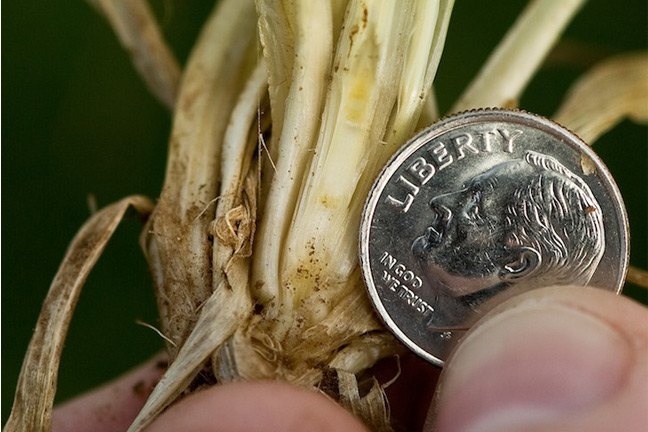
Agricultural News
First Hollow Stem Advisor Tool Available Through Mesonet
Mon, 27 Jan 2014 10:18:25 CST

March 15 has historically been a date for wheat producers to remember. Waiting much longer than that to pull cattle from wheat fields would result in a drastic decrease in yield.
Research has show that First Hollow Stem (FHS), a particular growth stage in winter wheat, is the optimal time to pull cattle off wheat to prevent yield loss. Using Mesonet weather and soil data, as well as FHS observations from the past 17 years, researchers at Oklahoma State University have developed a new tool for producers to consult when deciding how long to leave cattle on their wheat fields.
"Grazing too long will reduce wheat yields, but removing cattle too early will reduce the profit potential of the stocker cattle enterprise," said Jeff Edwards, OSU Cooperative Extension small grains specialist. "Finding the correct balance between these two factors has been the subject of investigation for decades."
Available on the Mesonet website (mesonet.org), the FHS Advisor is located in the Agriculture section, under both the "Crop/Wheat" and "Livestock/Cattle" tabs. A guide on how to use the Advisor is located in the "Learn More" section of the website. The tool utilizes a soil temperature based model to predict when FHS will occur.
"Looking at a variety of weather and soil variables, we found that 4-inch soil temperatures under sod cover were best correlated to FHS dates," said J.D. Carlson, agricultural meteorologist in the department of biosystems and agricultural engineering at OSU, and developer of the models used in the tool. "The Advisor includes separate models for three different FHS categories of wheat varieties - early, middle and late."
By visiting the website, producers can select their wheat variety to determine its category. Then maps, charts and graphs will provide information on the probability of FHS occurrence.
"Three maps are available for each FHS category," Carlson said. "They include a current map of observed soil heat unit accumulations since model start date, projected one-week soil heat unit totals and projected two-week soil heat unit totals. The projected maps are based on 14-year daily averages of observed Mesonet soil temperatures over the next seven or 14 days from today's date."
In addition to soil heat unit totals, probabilities for FHS are shown. A color scheme is used to show these levels of probability - blues for FHS probabilities less than 5 percent, greens for 5 percent to 10 percent, yellows for 10 percent to 25 percent, oranges for 25 percent to 50 percent, reds for 50 percent to 75 percent and browns for more than 75 percent.
"We recommend scouting for FHS once the greens start occurring in the grower's area, as FHS development starts to speed up at that point," Carlson said. "For those who don't scout, we recommend removing cattle by the date the 50 percent level is reached."
Over a period of time, 100 years for example, a 50 percent probability for FHS indicates that in 50 percent of those years, FHS would have occurred by that date. The same interpretation applies for other percentage values.
WebReadyTM Powered by WireReady® NSI
Top Agricultural News
More Headlines...



















